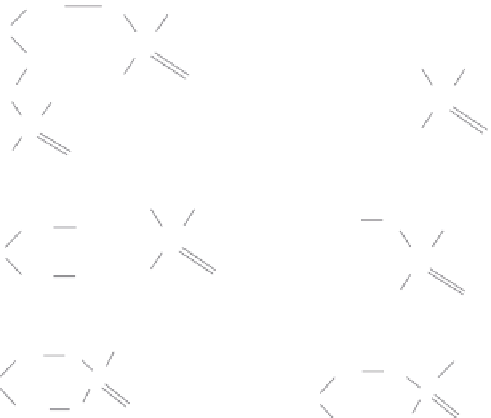Environmental Engineering Reference
In-Depth Information
31.2.3 Mechanisms for Sorption of Phosphorus
Soluble phosphate ions are removed from contaminated water by media either by bonding
with the surface (for iron-, aluminum-, or lanthanum-based media) or by precipitation (for
calcium- and magnesium-based media). The pH generally determines the effectiveness of
the media and associated phosphorous removal mechanism. In general, alkaline environ-
ments favor phosphorus removal by calcium adsorption and precipitation, whereas low
pH and acidic environments favor removal by iron and aluminum (Ugurlu and Salman,
1998).
31.2.3.1 Aluminum- and Iron-Containing Media
Under acidic to a neutral pH, phosphate ions are chemically adsorbed onto Fe and Al oxide
surfaces through ligand exchange (Wood and McAtamney, 1996). Engineered media con-
taining metal oxides are ideal for their high afinity toward phosphate molecules. Metal
ion (cation) bonds with phosphate ion (anion), forming inner-sphere surface complexes
(Figure 31.2) (Zach-Maor et al., 2011; Camm, 2011).
Several surface complexes can form with iron or other metal oxides, including mono-
nuclear monodentate, mononuclear bidentate, and binuclear bidentate (Zach-Maor et al.,
2011; Camm, 2011). Sorption capacity can be enhanced by increasing the effective surface
area, which can be achieved by reducing the particle size. Sorption reactions are affected
by competing species that may impede removal of pollutants. Changes in temperature can
also affect sorption processes. Higher temperatures increase the vibration frequencies of
sorbed molecules, making desorption more likely (Minton, 2002). The largest inluence on
sorption reactions is pH. In the presence of water, metal oxides are surrounded by hydroxyl
groups, protons, and coordinated water molecules (Liu et al., 2001). The metal oxides are
amphoteric, allowing them to act as either an acid or base. This property is inluenced by
the surface charge, and therefore pH, of the surrounding solution. In general, at a higher
OH
-
Fe
O
OH
O
P
-
O
OH
Fe
O
OH
O
OH
+
P
(b)
P
OH
O
OH
O
-
O
OH
OH
-
Fe
O
OH
Fe
OH
+
P
O
O
P
FeOH
Fe
OH
OH
O
O
OH
H
+
OH
OH
-
Fe
O
OH
Fe
O
O
P
P
O
Fe
O
O
-
O
FeOH
O
(c)
FIGURE 31.2
Types of phosphorus adsorption.















